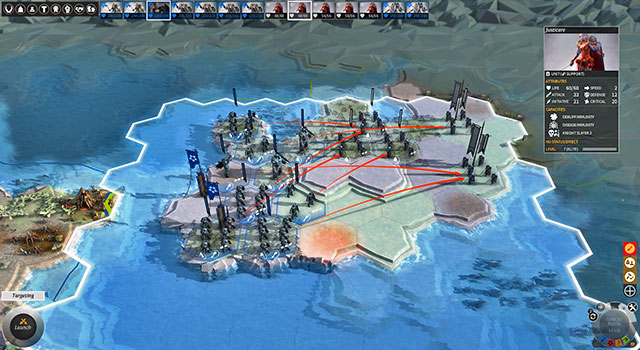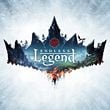Battle | War
Last update:

Before a battle
Pay attention to the type of terrain, where the battle is going to take place. After you roll over the enemy army, hold down the right mouse button to see the terrain. White lines mark boundaries and the big, white dots mark the initial deployment of troops. Terrain changes, depending on the side from which the army is attacked. To grasp the concept, stand right next to the enemy army to see what the battlefield would look like. Then, move over, by one hex, while still standing next to the opponent and check the future battlefield. You will notice the differences between the two cases.
Reinforcements do not need to stand on the future battlefield, not even in the same region. However, they need to be stationed within the distance of, at most, seven hexes of the field occupied by the opponent and have an action point. In other words, if they have already fought in this turn, they will be incapable of fighting again as reinforcements. They will only be able to fight, if directly attacked.
Battlefield is limited in size, which may decrease your chances of winning. For example, if there are tall rocks behind you, which you would like to put rangers on, make sure that there also is an approach to the rocks, within the battlefield. Otherwise, you will not be able to climb them.
Movement on the battlefield is subject to all the rules of movement, which you experienced on the main map. If you can climb a hill from the South, the unit approaching from the North will first have to walk around that hill. If a plain is intersected with forest, it will take more time to cross it. Pay attention to those of the landscape elements that provide an advantage in battle.
There is a trick connected with battlefield. Attack the opponent on the promontory, in a narrow passage or right next to strong rocky wall. If the opponent's side of the battlefield is too small, not all of his units will take part in the battle. In other words, if you are attacking a village at the edge of an island, it may turn out that you will be fighting against two defenders, instead of, e.g. eight. Simply, there will not be enough room for the rest of the units to be deployed, which is why the game will leave them for later.
If possible, summon reinforcements into the battle. If there is a city nearby, you can summon militia, garrison, or even the governer, if there is any around. Even militia can change a lot, because this always means one, or two, more units.
Remember that the battle ends as soon as one of the parties is destroyed, or if 6 rounds have elapsed. In such a situation, the remnants of both armies return to their initial positions and you get the battle report. You can then fight again, but you will have to fight the battle with another army, because the current one will be incapable to.
NOTE! After you have attacked an opponent's troop, you cannot retreat from the battle. The situation is similar if your army is attacked. If you want to avoid the battle, end the turn outside of the opponent's reach and watch out for what you are clicking on.
Initial deployment

At the beginning of each battle, troops of both sides take their positions at the edges of the battlefield. They do that automatically so, as soon as they finish, correct their positions. It may happen that crossbowmen are standing before the infantry lines, or cavalry takes positions in front of the forest, which would slow them down.
While deploying your troops, pay attention to three things:
Range of shooting. Crossbowmen cannot be deployed too far away from the opponent. If they are in their aggressive stance, they will be trying to approach the enemy and shoot afterwards. Otherwise, they will hold their ground and wait for the opponent to come within reach, which they will do only as soon as their turn comes. Do not deploy them too far in the back, or they will be waiting or busy looking for their way to the opponent, instead of fighting. The only exception is the situation, in which an enemy standing far away approaches you quickly. In such a situation, rangers will either attack immediately, during their turn, or approach a hex or two closer and fire in the same turn. After several battles, you will get the picture.
Order of movement. To grasp the importance of order of movement, you first need to grasp the rules that attack and counter attack are subject to:
A unit attacked fir the first time in the round, counterattacks. This only concerns fighting face to face.
A unit attacked for the second time in the turn does not respond with counterattack. This is why it pays off to attack with several units at a time. Only one of them takes damage then.
A unit attacked by rangers does not respond with counterattack. Rangers, if attacked by rangers, also do not counterattack. The same goes for support that also attacks over range.
Rangers respond, with a counterattack, to a direct attack, if they have not yet attacked, independently, in that turn. Otherwise, they take on the attack only. Distance, over which the attack took place does not matter. Only the instance of attacking.
With these in mind, find out about the order of movement of units, during the battle. If possible, deploy your units in a way that will make the opponent lose two turns of approaching them. If you can attack, an enemy unit, with several units, before he manages to do anything, do that. Also this requires a bit of training, but you should get it quickly.
Land formation. The rule is simple - the unit higher above gets bonuses, the one below gets penalties. Rangers on hills are a lethal weapon, but also infantry is capable of taking advantage of them. So, if possible, position your units on elevations. Also, take a note of airborne units, because they ignore certain limitations on movement.
Remember that you determine deployment of your fighting army only, and not of reinforcements. The latter are deployed by the computer so, be prepared.
Selecting of targets
Focus your fire. If the opponent has eight units, do not allow them to attack one after another. After the first turn, the enemy will still have eight units, only wounded, in a situation in which it could have five or six.
Units in the aggressive mode search for another opponent, after they have killed the previous one. This is a potentially dangerous situation, because they may attack a unit different from the one that you actually wanted to attack. This is why it is better to set targets for your units manually, rather than to have them all attack one opponent and hope that they will handle the situation.
Aggressive mode is useful if you have a high number of fast units. The remaining ones are better for slower armies, which prefer to wait for the enemy to approach. All depends on what kind of units you have under your command and what you expect of them. There is no one right strategy here, much depends on the land formation and the opponent. You should experiment, at best by attacking smaller enemy groups and find out about the effectiveness of diverse tactics.
Targets for your troops are selected in each round of the battle. This is important, because, at any point, you can walk away from the battlefield and take to your business. Still, if this takes too long, the battle will come to a standstill and your troops will be waiting for further orders.
If you want to hold a tighter control of the battlefield, change the time that may elapse between the individual orders that you issue. This will limit the situations, in which your units do something, in spite of your plans.
Support may attack an enemy unit, or reinforce one of their own. Their attacks are usually weak so, if they do nothing more than deal damage, you'd better have them serve as reinforcements for your troops.
Try not to waste your units. If something can be killed at a long range, kill it at a long range. If the enemy can be defeated with two units, do that. If the hero's armor is tough, and he has too many health points, have him block access to the weaker units. If there is no need to, have your units stand their ground, in a situation, in which rangers can get the job done on their own. Healing is time-consuming, or it costs Dust so, it is best to avoid losses. Especially among heroes, because healing them is the most costly.
If there is an enemy hero in the battlefield, try to take him out in the first place. If he acts alone, throw everything that you have at him. If he comes with reinforcements, have short-range units deal with them and kill the hero at a long range. Each high-level hero with good equipment is a formidable opponent. The faster you eliminate him, the better for you.
You are not permitted to copy any image, text or info from this page. This site is not associated with and/or endorsed by the Iceberg Interactive or Amplitude Studios. All logos and images are copyrighted by their respective owners.
Copyright © 2000 - 2025 Webedia Polska SA for gamepressure.com, unofficial game guides, walkthroughs, secrets, game tips, maps & strategies for top games.
